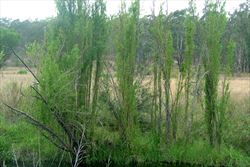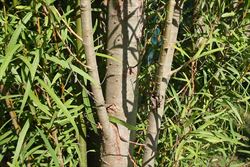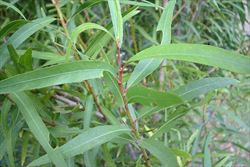Click on images to enlarge

infestation in a waterway (Photo: Sheldon Navie)
Photographer:
Sheldon Navie

infestation in a waterway (Photo: Sheldon Navie)
Photographer:
Sheldon Navie

smooth bark on main trunk and very upright branches (Photo: Sheldon Navie)
Photographer:
Sheldon Navie

young green twigs with elongated leaves (Photo: Sheldon Navie)
Photographer:
Sheldon Navie

leaves with finely-toothed margins (Photo: Sheldon Navie)
Photographer:
Sheldon Navie

habit of planted trees along a driveway (Photo: Sheldon Navie)
Photographer:
Sheldon Navie

habit (Photo: Sheldon Navie)
Photographer:
Sheldon Navie

habit (Photo: Sheldon Navie)
Photographer:
Sheldon Navie
Scientific Name
Salix humboldtiana Willd. 'Pyramidalis'
Synonyms
Salix chilensis MolinaSalix chilensis Molina 'Fastigiata'Salix humboldtiana Willd.Salix humboldtiana Willd. var. fastigiata André
Family
Salicaceae
Common Names
Chilean Pencil Willow, Chilean willow, Humboldt's willow, pencil willow
Origin
Salix humboldtiana is native to southern Mexico, Central America (i.e. Costa Rica, El Salvador, Guatemala, Honduras, Nicaragua and Panama) and South America (i.e. Brazil, Bolivia, Colombia, Ecuador, Peru, Argentina and Chile). Pencil willow (Salix humboldtiana 'Pyramidalis') is a cultivar of this species developed in horticulture.
Naturalised Distribution
This species is becoming naturalised in the coastal districts of eastern Australia (i.e. in eastern New South Wales and south-eastern Queensland). It is also sparingly naturalised in central Queensland and possibly naturalised in south-western Western Australia.
Notes
Pencil willow (Salix humboldtiana 'Pyramidalis') is regarded as a potential or emerging environmental weed in New South Wales, Queensland and Victoria. It is one of the willows (Salix spp.) that together as a group are regarded as a Weed of National Significance (WoNS).
This species is commonly planted in gardens in Australia, especially along fence lines and driveways. In its native range it is found along streams or in swamps and marshes, and it invades the same habitats in this country.

